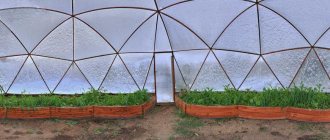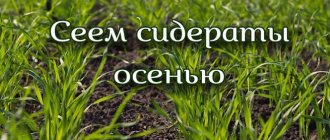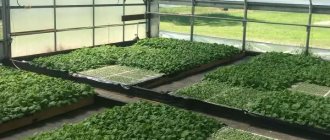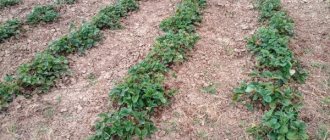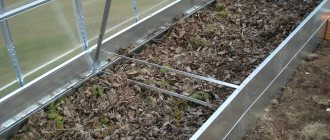Green manure for the garden in autumn, spring and summer brings great benefits to the garden and vegetable garden. These plants are sown in open ground or a greenhouse, and then mowed, embedded in the soil and received natural and inexpensive fertilizer.
But you can’t just sow the first seeds that come to hand, because every crop has good and bad predecessors. If you want green manure sown in the fall to germinate successfully, consider after which plants you can sow them. In turn, green manures themselves influence the crops that will replace them.
Green manure cannot be sown after main crops belonging to the same family, and vice versa.
- Crop rotation, or what to plant next in the garden
Useful information for those who want to harvest a good harvest of vegetables and herbs every year.
Green manure has the following valuable properties:
- suppress weed growth;
- saturate the soil with nitrogen and other useful substances;
- improve air exchange in the soil, loosen it;
- protect soil microflora from low temperatures;
- reduce the number of pests;
- prevent the spread of diseases;
- cover the bare ground and delight the eye with fresh greenery.
When the fruits and tops have been harvested from the greenhouse, it’s time to sow green manure. In the fall, this procedure will not take much time and will be an excellent alternative to replacing the soil in the greenhouse or adding manure.
How to sow mustard on green manure in the fall in a greenhouse. Features of sowing
Planting mustard in the fall is justified exactly where it is planned to grow tomatoes, zucchini, blueberries, peppers, melons, cucumbers, pumpkins and watermelons next season.
The plant secretes specific substances that prevent the development of bacteria, fungi, putrefactive microorganisms and late blight. But you should not sow this green manure crop in front of cabbage, radish, turnips or radishes. Related plants consume the same elements and suffer from the same diseases and parasites. Sowing is carried out immediately after harvesting. There is no need to waste time, as weeds will begin to sprout. The land should never be empty. The sequence of actions is as follows:
- Clear the bed of weeds, debris, tops and loosen thoroughly.
- If the soil is very depleted, fertilize it with humus (calculating a bucket per 1 sq. m. bed) and dolomite flour. Feeding is needed, otherwise green manure will take away the nutrients necessary for its growth and development from the already poor soil. It will take time to restore balance.
- Make shallow narrow rows (no more than 2 cm deep). The distance between them is approximately 16 cm. There is no need to bury them, as germination will be delayed.
- Sow mustard. You can also sow randomly, but then the seed rate needs to be increased. Dense plantings are good because dense seedlings will prevent erosion and leaching of beneficial components from the soil.
- Sprinkle the crops with soil and loosen them slightly with a rake. When sowing with a carpet, it is not at all scary that some seeds remain on top, since as a result of abundant watering they will sink deeper.
- Water (but don't overdo it).
To get a decent result, it is recommended to grow green manure every year and more than once per season.
Mustard in a greenhouse in the fall will help renew the soil and improve its quality. The soil in a greenhouse or greenhouse is used almost all year round, so it very quickly loses its useful characteristics. The use of green manure helps to quickly restore the soil and grow flowers or vegetables again. It is best to sow mustard using the continuous method to create a thick mat.
Features of crop rotation
White mustard belongs to the Cruciferous family, and therefore suffers from the same diseases as other members of the family.
The plot where mustard was grown cannot be used for 3-4 years for planting many garden crops, namely:
White mustard is the best predecessor for tomatoes and potatoes; after it you can plant:
Planting white mustard in the garden - under fruit trees, berry bushes and grapes - will be of great benefit.
What to do in spring with green manure planted in autumn. Features of autumn sowing
Green manure is planted in the fall as an independent crop. They are necessarily used after garden varieties, and especially such depleting crops as sunflower, corn, soybeans, and sorghum.
They work for 6 months and during this time they manage to loosen clay soils and loams and nourish sandy soils.
With the help of autumn, a number of important problems are solved:
- prevent erosive destruction, leaching of nutrients and minerals with rain and snow;
- protect the soil from freezing in winter and drying out in spring;
- maintain optimal crop rotation;
- form a layer of humus;
- create food for soil bacteria and microorganisms;
- give the soil looseness and lightness.
For winter sowing, plants with a strong root system are selected to increase porosity and looseness.
Agricultural technology
There are two possible techniques for sowing fertilizer plants:
- In rows or stripes. The width of the tape varies from 5 to 20 cm. The row spacing is within 10-15 cm. When the maximum green mass is achieved, the tops are cut off and buried to a depth of 5-7 cm. Can be left on the surface for use as mulch.
- Randomly. They are scattered thickly throughout the area in a carpet. Sprinkle with a layer of 3-4 cm. Use soil from the garden bed or a thin layer of compost. No deep plowing or digging required. It is enough to trim and leave the stems 2-3 cm high. The roots are left to rot, the shoots are sealed or used for subsequent mulching. You can mow the green carpet in the spring - bury it or use it as mulch.
Green manure is plowed to a depth of 6-7 cm, not deeper.
It is at this level that active soil bacteria, fungi, and worms live. With deeper digging, the plant material will rot and the earth will become compacted, instead of the desired loosening.
When to sow?
The timing of planting green manure varies from the beginning of September to the first ten days of October. Before frost, the stems should have time to grow to 5-10 cm.
Scheme for growing autumn green manure:
- Sowing in the first 2 autumn months.
- Care with infrequent watering.
- Cutting and spreading over the surface.
- Shallow plowing if necessary.
- Sowing vegetable or grain plants in spring.
- Harvesting and regular work on planting green manure.
When to dig and mow?
There are 2 options for how to deal with green manure crops sown in the fall:
- prune after regrowth and plow into the ground;
- Leave in the garden for the winter without cutting.
To restore the soil, 2-4 annual plantings in winter are sufficient.
| Basic green manure | Sowing period | When to mow | Norm of seed material in g per 1 hundred square meters |
| Winter rapeseed | 3 weeks before sowing winter cereals | spring | 100-110 |
| Phacelia | first ten days of September | in 1.5 months | 110-120 |
| Mustard | beginning of September | in 1 month | 300-400 |
| White sweet clover | first ten days of September | 2 months later | 200 |
| Oilseed radish | first half of September | 2 months later | 200 |
| Winter rapeseed | 3 weeks before planting grain | early-mid March | 100-120 |
| pink clover | throughout September | 10-14 days before the main culture | 170 |
Experienced farmers combine green manure plants with different properties.
The most successful tandem is legumes and grains. There should always be at least 50% legumes to ensure adequate nutrition.
In this combination, a variety of minerals and organic nutrition will enter the soil layers. Due to the different root structure, the soil will loosen as much as possible at the desired levels. Humus will not be washed away.
If you sow green manure from the same family as the crop, the effect will be insufficient. The same diseases and deficiency of the same minerals are possible.
Proper care
White mustard is unpretentious and grows on virtually any soil. It develops worse on heavy, swampy soils; it prefers sandy and loamy loose soils.
The plant is insensitive to acidity, acceptable limits are pH 4.2-8.2. But a slightly acidic substrate (pH 6.2) is optimal for it. The culture is photophilous, but can also grow in partial shade.
The only requirement for white mustard is regular watering. Green manure does not tolerate drought because it has shallow roots. If there is no rain, it is watered once every 7 days. Per sq. meter requires 10 liters of water, no more - waterlogging is also harmful.
When sowing in rows, it is also necessary to loosen the soil and remove weeds. No feeding is required - green manure absorbs nutrition that remains in the soil after other plants, since it is inaccessible to them.
What to do with mustard planted in the fall. Why do you need to use mustard as green manure in the fall?
Autumn planting of mustard as a green manure crop allows you to achieve the following results:
- Structure the soil, making it soft and loose.
- Saturate the soil with humus formed during the decomposition of greenery.
- Enrich the soil with various nutrients and microelements extracted from deep soil layers (K, P, N, etc.).
- Convert poorly soluble and poorly digestible substances into a form more accessible to plants.
- Scare away harmful insects (slugs, wireworms, etc.).
- Reduce the growth of weeds in vacant areas.
- Retain more snow rather than reduce soil freezing.
- Prevention of wind erosion, due to which the upper fine layers are carried away.
- Disinfect and disinfect the soil using specific essential oils contained in the ground green mass that inhibit the development of pathogenic microflora (phytophthora, scab, etc.).
- Prevent erosion by spring meltwater.
By planting mustard as a green manure in the fall before winter, you can significantly improve the composition of the soil and maintain the natural balance of nutrients and microelements in your garden or garden plot
However, it must be remembered that mustard should not be planted in the place where its closest relatives from the Cruciferous family (radish, radish, cabbage, turnip, etc.) grew. These crops are characterized by common diseases and insect pests (cabbage moth, cruciferous flea beetle, phomosis, powdery mildew, etc.).
When to mow
White mustard should be mowed before its stems become woody, otherwise the green manure will take a long time to rot.
The process begins after flowering, before that the leaves and shoots are very tender, the soil microflora quickly processes them.
And, of course, the seeds should not be allowed to ripen, otherwise the mustard will spread uncontrollably throughout the area.
Mustard blooms a week after the buds appear, but it is better to cut the tops at the beginning or on the eve of budding.
At this point, the bush accumulates a maximum of nutrients in the leaves and stems in order to spend them on the formation of flowers and ovaries.
The plant increases its green mass within 30-50 days from seed germination, reaching 30-40 cm in height by the beginning of flowering. It is optimal to mow green manure 40 days after germination.
If the soil is heavy, it is dug up along with the tops with a shovel. In such soils, green manure takes a very long time to decompose.
In other cases, agronomists recommend sealing the bushes when weeding or using a flat cutter so that the green mass remains in the surface layer of the soil.
Soil microorganisms that decompose plant residues work more actively in a humid environment.
If there is no rain, pour 2 buckets of water onto a square of land at least once a week.
You can speed up the process of decay using preparations with bacteria.
Suitable for this purpose:
But if organic fertilizers have not been applied to the garden bed for a long time, the bacteria will not take root in the soil.
You cannot occupy an area for the next crop before 1-2 weeks have passed after planting mustard - when green manure rots, it releases substances that inhibit the growth of other plants.
Since white mustard is not resistant to some diseases, after harvesting it is advisable to treat the soil with Fitosporin. Do two waterings 7 days apart.
Green manure for tomatoes in the greenhouse. The best green manure for tomatoes in the fall
The composition of green manure for autumn sowing depends on where you plan to grow tomatoes - in a greenhouse or in open ground.
The dates indicated below are relevant for the middle zone. If you live in southern latitudes, they move forward 2 weeks. For cold climates, you need to count 1.5-2 weeks ago from the given dates.
What to sow in a greenhouse before mid-September
Cruciferous green manures - oilseed radish, white mustard, spring rape, spring rapeseed.
All these plants loosen the soil to great depths, saturate it with nitrogen and potassium, and also suppress pathogens of fungal infections. But my favorite is white mustard - it is a real record holder for the speed of green mass gain. She is also super unpretentious.
Legume green manure - annual lupine, peas, spring vetch, seradella.
Legumes are used as green fertilizer when your main goal is to saturate the soil with natural nitrogen.
From this list, I advise you to pay attention to peas and annual lupine. Lupine is especially good in this regard. It not only provides complete nitrogen fertilization, but also inhibits the development of pathogenic bacteria in the soil.
And according to American agronomists, the best green manure for tomatoes is vetch. It has been experimentally proven that growing it in a tomato bed gives an increase in yield of up to 50%!
Phacelia and buckwheat. Of these two crops, it is better to choose phacelia. It works no worse than mustard, and also helps normalize the acidity of the soil in the greenhouse.
What to sow in the greenhouse before the end of October
Spring rape
We usually remove the last tomato plants from the greenhouse in mid-October. At this time, it is already too late to sow spring crops indoors - they will not have time to grow even to 10 centimeters before the onset of cold weather.
In such a situation, winter rye and winter oats help out. Before winter arrives, they manage to emerge and slowly grow until severe frosts.
Cereals are famous for their phytosanitary properties. This is also the best option if you need to thoroughly loosen the greenhouse soil and protect it from erosion processes in the off-season.
What to sow outdoors in September
It is useful to add some lupine or pea seeds to winter green manure cereals.
In open ground, it is good to plant tomatoes the next year after mid-season vegetables - cauliflower, zucchini, cucumbers, asparagus and regular beans, beans. But these crops usually leave the beds no earlier than September, when it is too late to sow most green manure crops.
Until the end of September, winter rye and winter oats can be sown in open ground. In this case, the plants are left in the garden until spring.
If cabbage or pumpkin plants (cucumbers, zucchini, squash) grew in the garden before, I advise you to pre-fill the soil with fertilizers (per square meter):
- compost, humus - ½-1 bucket;
- complex mineral fertilizer - 5-7 grams.
After legumes, only phosphorus and potassium fertilizers are applied at the same rate - 5-7 grams per square.
Beneficial features
The great advantage of white mustard as green manure is its ability to consume nutrients that are in a form inaccessible to most plants.
During growth, the bush accumulates nitrogen, phosphorus and potassium, and when the tops rot, the nutrients are released in the form of easily digestible compounds that can be absorbed by other crops.
From 1 hectare of planting, up to 4 centners of nutritious green mass are obtained.
In addition, mustard improves soil quality in a number of indicators:
Due to its high phytosanitary qualities, white mustard can be used to shorten the crop rotation cycle. Crops from which the site must rest for 3-5 years can be sown after green manure within 1-2 years.
Mown tops make good mulch for insulating beds and retaining snow in winter.
The green mass can be placed in compost or allowed to rot directly in the soil in the garden bed.
What to do with mustard in the greenhouse. Is it necessary to dig up mustard sown in autumn?
Green manure (mustard, including), sown in spring and summer, is always dug up and embedded in the ground in order to get the maximum benefit from them. But with winter crops, everything is not so clear. There are diametrically opposed opinions on this issue.
There are several points of view on what to do with mustard in the fall
When they dig up
They usually try to bury mustard planted in late August or early September, since during a long and warm autumn the crop may not only have time to bloom, but also throw out seeds, which will sprout in the spring and act as weeds. In addition, hardened peduncles are more difficult to crush and decompose more slowly. To avoid this, simply mow the grass without waiting for the pods to ripen. Plowing can significantly speed up the process of decomposition of green raw materials.
It is during the budding period and at the very beginning of flowering that the mustard green mass is most saturated with useful substances.
It is advisable to have time to cut and dig up the mustard before flowering, as the stems then become hard and decompose worse.
If a large number of wireworms are found during harvesting, then the mustard planted to combat the pest must be dug up, trying to embed the above-ground part completely into the ground, while turning the earthen clods with plants 180°. The unpleasant and pungent smell of rotting greenery perfectly repels this parasite, after which it changes its location and leaves the area.
When they don't dig up
If sowing is done late (September, October) or there is a sharp fall in temperature, the green manure obviously does not have time to produce buds, so it is left untouched. Young shoots die during severe frosts and lie on the ground themselves, covering it from frost and retaining moisture. There is no point in digging up very small (5–8 cm) seedlings. The greenery remaining in the garden will rot on its own before the onset of spring warmth and saturate the soil with organic matter, so you should not waste time and physical effort on a useless activity. In the spring, you just need to lightly cover the remains with a rake and then plow when necessary.
There is no point in digging up mustard seedlings; they are left in the garden until spring
Dying mustard roots, left untouched, structure the soil and give it lightness. The top layer of soil remains loose and soft; a hard earthen crust does not form on it after the snow cover melts. Digging disrupts the soil capillary system, causing its microflora to suffer.
Adherents of natural farming generally try not to overturn clods of soil, as this kills the beneficial bacteria living near the surface of the soil.
I usually sow green manure in place of harvested potatoes. In Siberia, the cold comes already in October, so the crop does not have time to grow much. The seedlings go under the snow and almost completely decompose over the winter.
Tips and tricks for gardeners
Planting and growing unpretentious green manure in a greenhouse is not very difficult - you practically don’t even need to water them, there is enough water after the snow melts. Proper mowing of tops of green manure crops is very important. Below are some tips and tricks for hosting an event.
Mowing green manure
- In the spring, green manure for tomatoes must be cut in advance - 2 weeks before planting.
- Excess nitrogen in the soil will negatively affect the yield of tomatoes, so the growth of legume green manures must be carefully monitored and not allowed to grow to large sizes.
- Timely mowing of tops is important for another reason - overgrown green manure decomposes more slowly in the soil, since their stems become denser as they grow.
- After cutting, it is recommended not to plow the tops into the soil, but simply spread them out on the beds. The fact is that when plant residues are incorporated into the soil, many nutrients are lost.
- When mowing green manure, it is important not to damage their root system, so the flat cutter should not be buried more than 5 cm into the ground.
The right choice, early sowing and timely mowing of green manure will allow you to naturally prepare greenhouse tomato beds in the spring before planting the crop without the use of agrochemicals.
Common mistakes
It would seem that what is difficult about sowing mustard seeds in the garden? However, errors still occur. Let's look at the most common ones.
- Mustard is not watered after sowing. The soil under this crop should not be allowed to dry out. Therefore, provide moderate but constant watering.
- After sowing, the garden does not need to be harrowed. Because of this, the seeds are carried by the wind or pecked by birds.
- Mustard is sown in place of cabbage or radish. These are related plants. You cannot plant them side by side or alternate plantings.
- Mowing is done too late. Green manure must be removed before the seeds ripen, otherwise the green manure will turn into a weed and fill the entire garden.
- Planting too often or too sparsely. To maximize the effect, use 400 grams of mustard per hundred square meters (that’s 2.5 kg per 6 hundred square meters). Try to distribute the grains evenly so that there are no empty spaces.
Let's make a proportion
Having decided to resort to a mixture of green manure rather than any specific one, you need to find out which part will belong to one or another. Experienced vegetable growers who cultivate tomatoes in a greenhouse in a monoculture without crop rotation have come to the conclusion that this is possible without soil rotation, but using the services of green manure.
The mixture contains:
- oats - 100 parts;
- vetch - 30;
- mustard - 30;
- rapeseed 30.
The crop seeds are mixed together and sown with a rather generous hand. The mixture has proven itself both on light soils and on heavy ones that require improvement of the structure.
Those who sow with this mixture from year to year recommend it as universal, not requiring additional adjustments.
If sowing is carried out during the period when the tomatoes continue to bear fruit, then after its completion the tomato plant is not dug up by the roots, but is pruned at ground level. By autumn, green manure forms a continuous green carpet. Even if during severe frosts the bottom of the crops disappears, the rest will pick up the baton and take its place.
Experienced summer residents know why green manure is needed and what benefits they bring to agriculture. For beginners, the term “green manure” may mean nothing. But, in fact, green manure plants bring great benefits to summer cottages. Experts who professionally grow vegetables and grains will tell you what it is.
Choice of culture
When choosing green manure for tomatoes in a greenhouse, there is no point in giving preference to any one type. A mixture of crops is a lifesaver that will provide:
- will increase the level of nitrogen in the upper soils;
- will lift minerals from deep layers of soil;
- makes minerals biologically available;
- suppresses the growth of pathogenic microflora;
- eliminates the need to completely replace soil;
- improves the physical structure of the soil.
Each vegetable grower is free to create a mixture for tomatoes himself, taking into account his experience, knowledge, climatic conditions and soil conditions. However, you can take advantage of other people’s growing experience and try it in your greenhouse.
Selection
The mixture of crops for sowing tomatoes should consist of:
- cereals;
- legumes;
- cruciferous
Cereals
The basis of the green manure mixture is cereals, of which you can give preference to oats or rye.
When sown simultaneously, these crops behave restrainedly and tolerantly. Those who practice filling the greenhouse with snow should not refuse this; the cereals will accept it as they should.
In the spring, the cereals will continue to grow until the tomato seedlings are planted. The mowing of cereals can not be removed, but used as mulch. If compact planting with green vegetable crops is practiced, then the cereals are put into compost or dug up.
Cereals are particularly good at converting potassium into accessible forms. This element plays a major role in carbohydrate and nitrogen metabolism. Potassium affects the strength of tomato stems and the accumulation of sugar content in the fruit. With a deficiency of this element, the formation of buds is delayed.
Legumes
If there is a nitrogen deficiency, then legumes cannot be avoided. Assimilating nitrogen from the air, fixing it with the help of nodule bacteria, and giving it to the soil, plants of this group carry out nitrogen fertilization of tomato bushes. The coefficient of use of nitrogen of plant origin by tomatoes is almost twice as high as that of nitrogen of mineral origin.
Vetch is used as an additive as the best green manure for tomatoes. This crop gets along well with oats and enriches the soil with nitrogen, and tomatoes treat it very favorably, doubling the yield.
Cruciferous
We should dwell on these crops in more detail, since they play the main and decisive role for tomatoes in several aspects.
The root system of cruciferous green manure is abundantly “hung” with bacteria. They need iron to survive. There is a lot of this element in soils, but it is in an inaccessible form, but microorganisms convert it into an accessible form and cruciferous plants consume it with pleasure. Iron, in turn, is also necessary for pathogenic fungi, but cruciferous mushrooms “steal” it so skillfully that fungal ones simply do not have time to consume it. This is the basis for the mechanism of the fungicidal action of cruciferous crops to protect tomatoes from late blight.
One of the best crops is mustard. In summer it is sown in a mixture with other crops. Some vegetable growers practice sowing mustard in February-March, spot-on, sparse sowing allows to plant tomato seedlings between these plantings without destroying the green manure.
During the entire growing season, mustard is pruned, preventing the budding phase.
Sometimes vegetable growers find out: “Which green manure is better to sow under tomatoes in the fall - mustard or rapeseed?” However, experience shows that these are not mutually substitutable cultures, but complementary ones.
Rapeseed belongs to the cabbage family. Its plant tissues are very delicate and when they fall into the soil after mowing, they are quickly decomposed by microorganisms, turning into nutrients for the tomato.
Answers to frequently asked questions
On what soil can this green manure be planted?
Almost any type of soil except clayey soil. Mustard is a very unpretentious crop.
How to care for green manure plantings?
The main thing is to water if the summer season turns out to be dry. In fact, nothing more needs to be done.
When to mow mustard and bury it in the soil?
In about a month and a half. In good weather conditions - earlier.
For which crops is green manure useful?
For almost all major vegetable crops except cabbage. Mustard crops are grown for potatoes, garlic, tomatoes, eggplants, peppers, and berries.
Where to buy green manure?
Now it is sold in many hardware stores and agricultural markets. Usually this is a package weighing 400 grams. This amount is just enough for 1 hundred square meters.
